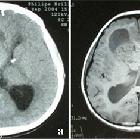subependymal giant cell astrocytoma












Subependymal giant cell astrocytomas (SGCAs or alternatively SEGAs) are benign tumors (WHO grade I), seen almost exclusively in young patients with tuberous sclerosis. They can be either asymptomatic or symptomatic due obstructive hydrocephalus, surgery treatment is often curative.
On imaging, they classically appear as an intraventricular mass near the foramen of Monro, larger than 1 cm, showing calcifications, heterogeneous MRI signal, and marked contrast enhancement.
Epidemiology
Subependymal giant cell tumors are a well-known manifestation of tuberous sclerosis, affecting 5-15% of patients with the condition . They are principally diagnosed in patients under 20 years of age, only occasionally found in older individuals.
Although they are almost exclusively encountered in the setting of tuberous sclerosis, case reports of isolated subependymal giant cell astrocytomas in individuals with no other stigmata of tuberous sclerosis are available .
Clinical presentation
Subependymal giant cell tumors are often asymptomatic. When symptoms occur, they are usually a result of obstructive hydrocephalus because of mass effect around the ventricular system at the level of the interventricular foramen (of Monro).
Pathology
Subependymal giant cell astrocytomas are considered WHO grade I lesions in the current (2016) WHO classification of CNS tumors .
Macroscopic appearance
These tumors are multilobulated well-circumscribed tumors arising from the wall of the lateral ventricles near the foramen of Monro. They frequently contain cysts and calcification .
Microscopic appearance
Subependymal giant cell astrocytomas are believed to arise from a subependymal nodule present in the ventricular wall in a patient with tuberous sclerosis, although this has yet to be categorically established .
Histologically, subependymal nodules and subependymal giant cell tumors are essentially indistinguishable, and the distinction lies in the potential for growth and mass effect . The cells that appear astrocytic, usually resemble gemistocytes; large polygonal cells with prominent eosinophilic cytoplasm. A smaller number of ganglionic appearing giant pyramidal-like cells .
The ependymal lining over subependymal giant cell astrocytomas remains intact making CSF seeding highly unlikely .
Current evidence suggests that they are of a mixed neuronal and glial lineage, although they continue to be classified as astrocytomas .
Immunophenotype
Immunohistochemical examination of these tumors demonstrates the following reactivity :
- S100: positive
- GFAP: variable
- synaptophysin: variable
- CD34: negative
- additional variable and focal reactivity: class III beta-tubulin, NeuN, SOX2
Radiographic features
The foramen of Monro is the classic location, and the tumor arises when a subependymal nodule transforms into subependymal giant cell astrocytomas over a period of time.
CT
- typically appears as an intraventricular mass near the foramen of Monro
- they are usually larger than 1 cm
- lesions are iso- or slightly hypoattenuating to grey matter
- calcification is common and hemorrhage is possible
- accompanying hydrocephalus may be present
- often shows marked contrast enhancement (subependymal nodules also enhance)
MRI
- T1: heterogeneous and hypo- to isointense to grey matter
- T2: heterogeneous and hyperintense to grey matter; calcified components can be hypointense
- T1 C+ (Gd): can show marked enhancement
Treatment and prognosis
Young children who have tuberous sclerosis may be offered to screen because of the increased risk of developing subependymal giant cell astrocytomas.
The main treatment is surgery, which is indicated if a tumor is symptomatic, or growth is demonstrated on MRI. Surgery is often curative. Oral sirolimus has also been trialled .
Differential diagnosis
In the clinical context of known tuberous sclerosis, the appearance is virtually pathognomonic, and the main differential is between a subependymal nodule and a subependymal giant cell astrocytomas. Serial imaging is most helpful here, as growth implies the latter.
Other general considerations include:
See also
Siehe auch:
- Tuberöse Sklerose
- intraventrikuläre Neoplasien und Läsionen
- Karzinom des Plexus choroideus
- Plexuspapillom
- intraventrikuläre Neoplasien und Läsionen - Überblick
- intraventrikuläres Neurozytom
- Riesenzellastrozytom
und weiter:
- Astrozytom
- WHO-Klassifikation der Tumoren des zentralen Nervensystems
- neuroradiologisches Curriculum
- periventrikuläre Heterotopie der grauen Substanz
- mass involving the foramen of Monro or/and superior third ventricle
- diffuses Astrozytom
- giant cell astrocytoma in a patient with tuberous sclerosis
- tuberous sclerosis diagnostic criteria
- subependymale Hamartome
- Foramen interventriculare Monroi
- Stenose des Foramen Monroi

 Assoziationen und Differentialdiagnosen zu subependymales Riesenzellastrozytom:
Assoziationen und Differentialdiagnosen zu subependymales Riesenzellastrozytom: nicht verwechseln mit:
nicht verwechseln mit: 





